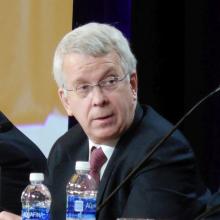ORLANDO – When the Heart Rhythm Society and several collaborating groups published in October 2017 the first revised consensus statement on atrial fibrillation ablation in 5 years, the document included a novel and perhaps unexpected suggestion: Ablation for asymptomatic atrial fibrillation “may be considered.”
This was “the first time” any group of experts suggested an indication potentially existed for ablating asymptomatic atrial fibrillation (AF), Hugh Calkins, MD, said at the annual International AF Symposium.
“You might say ‘are you out of your mind recommending ablation for asymptomatic AF?’ ” conceded Dr. Calkins, professor of medicine and director of the arrhythmia service at Johns Hopkins Medicine in Baltimore. But Dr. Calkins quickly added that this was a “soft” recommendation by being in the “may be considered” category, and he also noted that it received broad support from about 90% of the members of the statement’s 60-member writing group (Heart Rhythm. 2017 Oct;14[10]:e445-e494).
In addition, he personally believed that an amber light for this strategy made a lot of sense.
“I have done it. I think that catheter ablation has gotten to the point in terms of safety and efficacy that this is reasonable,” Dr. Calkins said in an interview.He also acknowledged that this recommendation is sort of buried in the text of the consensus statement and does not appear in any summary diagram “because the reviewers wanted us to hide it. Only those who are passionate about ablation know about it.
“Our goal was not to send a message that this is for everyone. It’s for very select patients and for very select operators after a very careful discussion” of the risks and potential benefits from performing the procedure on a truly asymptomatic patient.
The ideal candidate for this approach would be a relatively young patient, say someone in their 50s, who is identified as having AF incidentally, such as someone with an irregular pulse that’s found during a routine examination that leads to an ECG and definitive identification of AF despite the patient’s complete denial of having symptoms.
The next step, Dr. Calkins suggested, would be to treat the patient with an antiarrhythmic drug, such as amiodarone or flecainide, and with cardioversion and see whether this stops the AF and makes the patient feel better. If the patient reports improvement, it suggests the AF really is symptomatic and management could then proceed as with any case of symptomatic AF. But if the patient perceives no change and the AF then recurs in a persistent presentation despite drug treatment, the cardiologist could then discuss with the patient the pros and cons of an ablative procedure.
The pros for immediate ablation are that, when left unablated, the patient will face a substantially increased lifetime risk for stroke, dementia, and new onset heart failure, and after 2-3 years of continued persistent AF the left atrium would remodel and become much less likely to respond to ablation with little prospect for the patient ever returning to a normal sinus rhythm. “It’s either a rhythm control strategy now, or we’ll leave you in AF for the rest of your life,” Dr. Calkins explained. “If I were 50 years old and had asymptomatic AF, there’s no way I’d want to have AF for the rest of my life.” The risks from ablation are that the procedure has about a 68% success rate and about a 1% rate of complications.
“A patient with asymptomatic paroxysmal AF doesn’t have much to lose by waiting and seeing whether symptoms develop, but for the patient with persistent AF there is a penalty for allowing continuous AF, because after 2-3 years you won’t be able to successfully ablate it. In the past, we left patients with asymptomatic AF that way for the rest of their life, but now we know that if patients remain in AF over time, they will lose the option to have it ablated, and their risk of stroke, dementia, and heart failure will increase.”Dr. Calkins has been a consultant or adviser to or received honoraria from Abbott, AtriCure, Boehringer Ingelheim, Boston Scientific, iRhythm, Medtronic, Pfizer, St. Jude, and Toray, He has also received research funding from Boston Scientific and Medtronic.
This article was updated 2/9/18.


